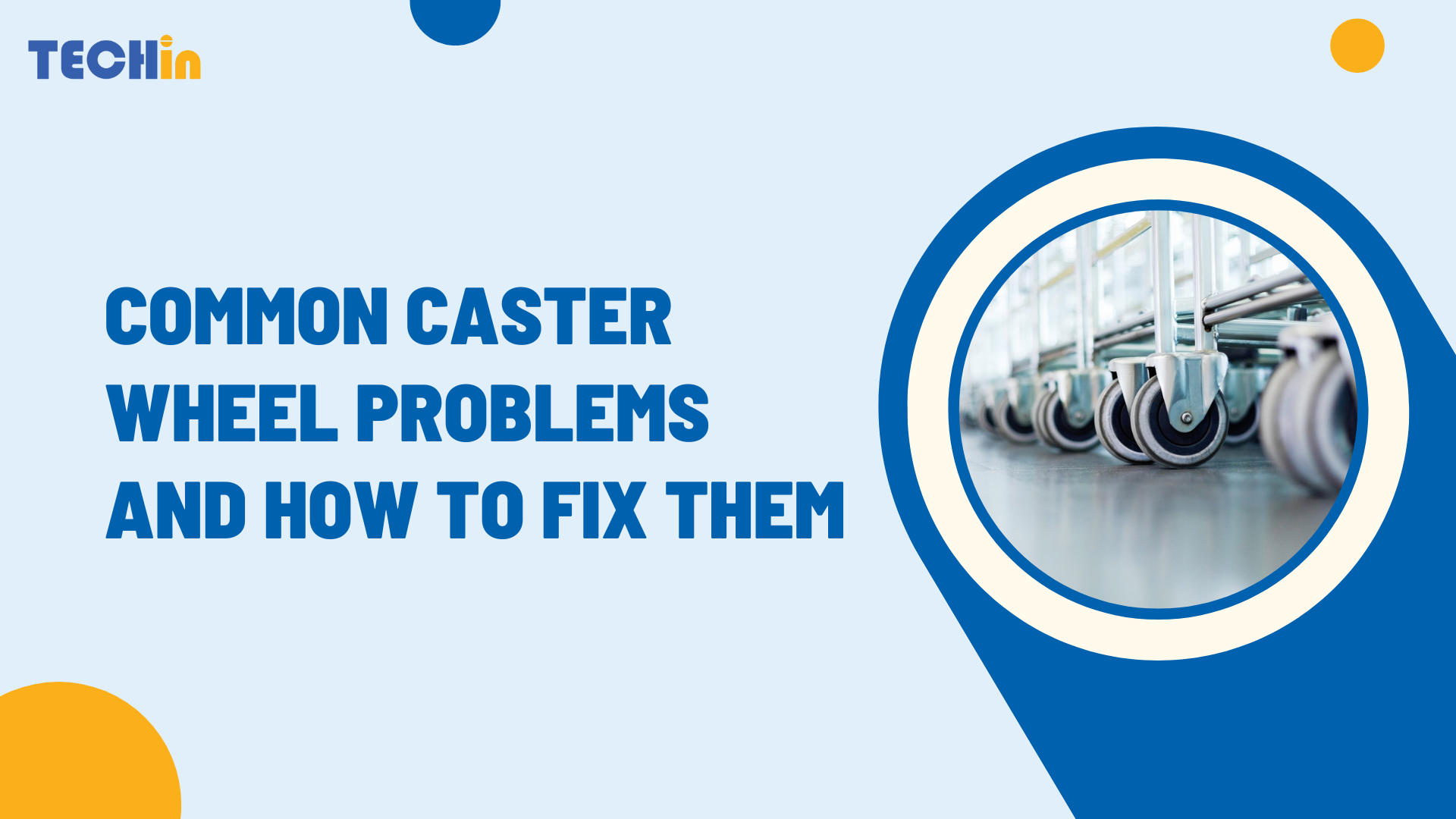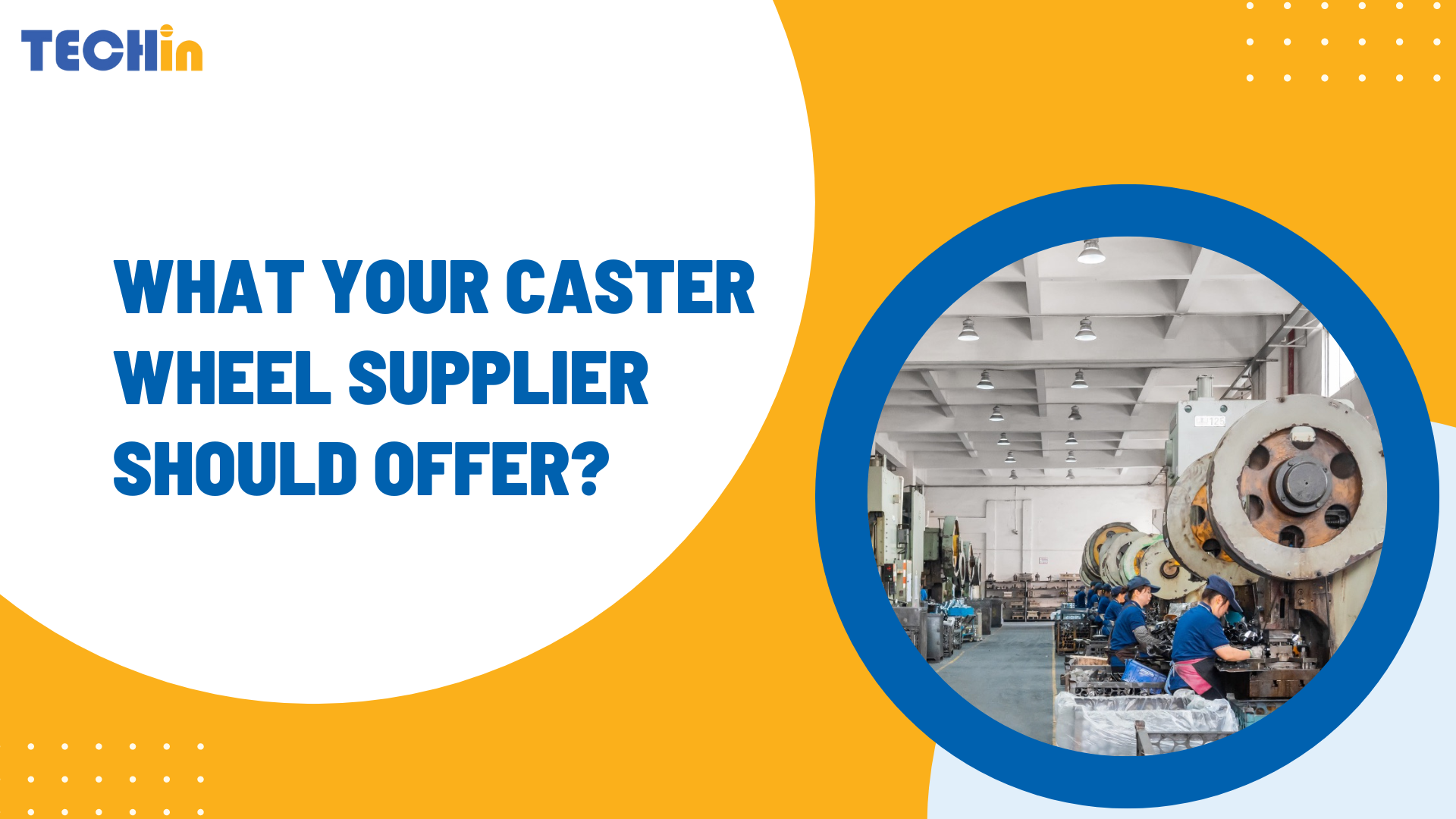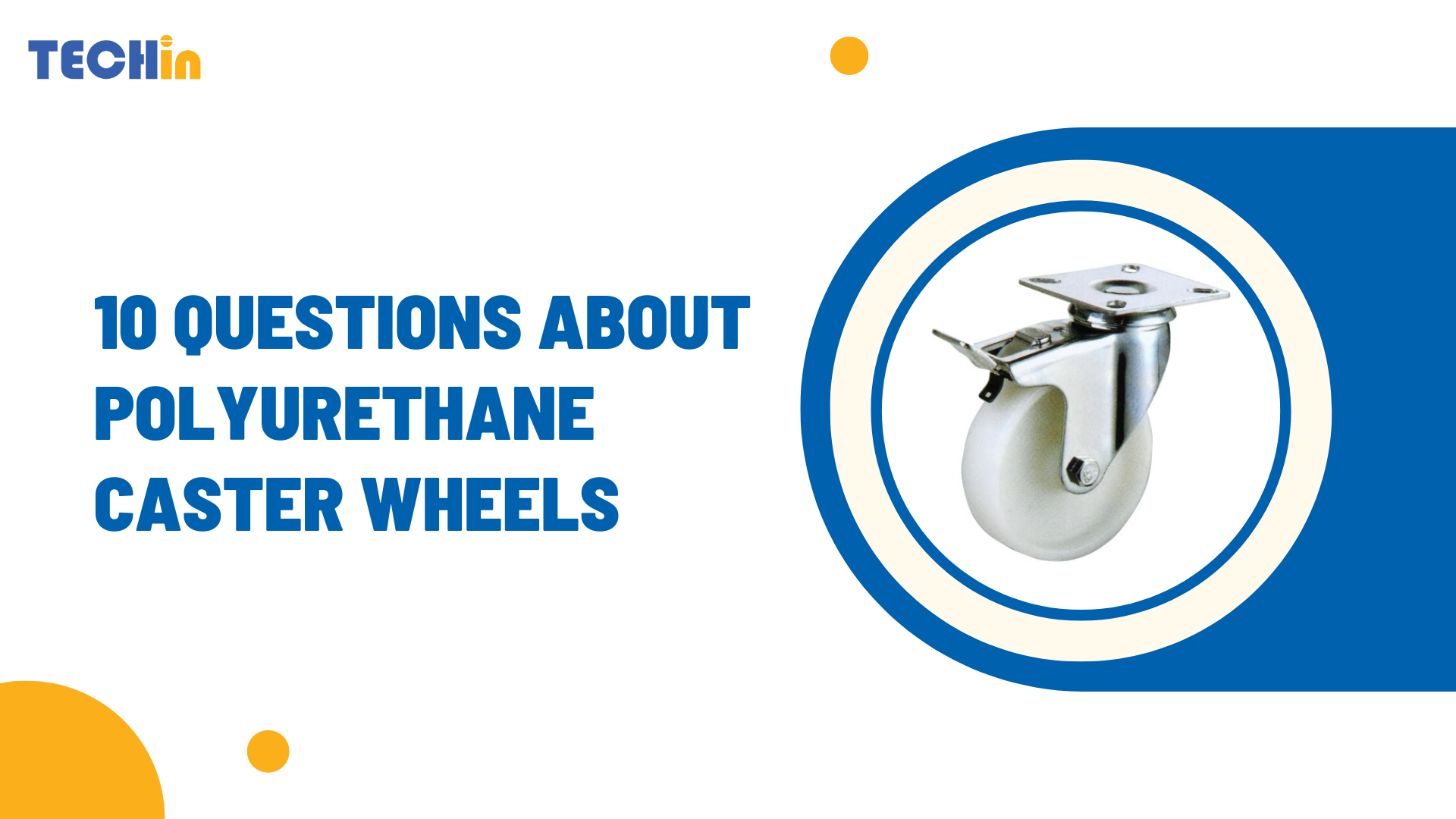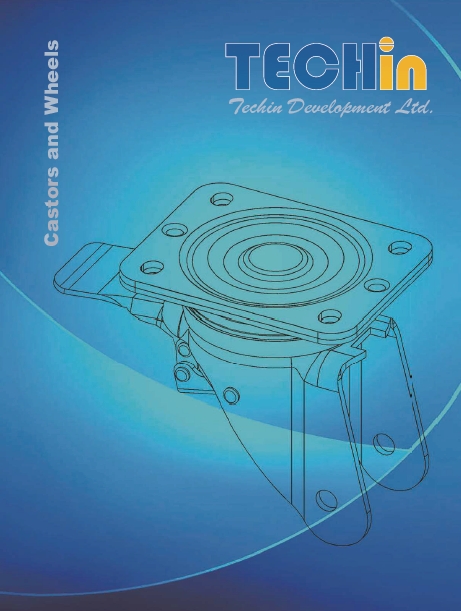Choosing the right caster wheel can make a big difference in how well your equipment works and how safe it is. Whether you’re putting casters on a hospital bed, a cart in a factory, or an office chair, knowing what to look for will help you make the best choice for your situation.
When choosing a caster wheel, consider the environment, load capacity, floor condition, wheel type, frequency of use, mounting type, wheel size, bearing type, brake type, and swivel radius. These factors will help you select a caster wheel that meets your specific requirements and ensures smooth, efficient, and safe operation.
Let’s take a closer look at each of these things to help you make the best choice.
1. What is the environment in which the caster will be used?
The environment is a big factor in what kind of caster wheel you need. For example, if you’re using a caster in a wet or corrosive environment, you’ll want one made of materials that won’t rust. If you’re using casters around chemicals or in extreme temperatures, you might need special materials to handle those conditions.
- Indoor vs. Outdoor: Indoor environments are usually pretty easy to deal with because you can control the conditions. Outdoor environments, on the other hand, expose your casters to all kinds of weather, so you need to use materials that can handle it.
- Special Conditions: In places like hospitals, where cleanliness is really important, you’ll want casters made of materials that are easy to clean. In industrial settings, you might need casters that can handle oil, chemicals, or getting banged around.
| Environment | Recommended Material |
|---|---|
| Indoor | Rubber, Nylon, Polyurethane |
| Outdoor | Polyurethane, Steel, Cast Iron |
| Wet/Corrosive | Stainless Steel, Zinc-Plated Steel |
| Chemical Exposure | Phenolic, Thermoplastic Elastomers |
| Extreme Temperatures | High-Temperature Thermoplastics |
2. What is the load capacity required for the caster?
Load capacity is one of the most critical factors. You need to make sure the caster can support the maximum weight it will carry, including any extra force that might be put on it. If you overload a caster, it will wear out faster and could be dangerous.
- Calculating Load Capacity: To determine the required load capacity, calculate the total weight of the equipment and its contents, then divide by the number of casters. To be safe, you might want to add a little extra to account for uneven weight distribution or extra force.
- Dynamic vs. Static Loads: You need to think about both the static load (the weight when the equipment is sitting still) and the dynamic load (the weight when the equipment is moving). Dynamic loads can put more force on your casters, so you might need a higher capacity rating.
| Load Type | Considerations |
|---|---|
| Static Load | Weight when stationary |
| Dynamic Load | Weight when in motion |
| Uneven Distribution | Add a safety buffer |
| High-Impact | Use casters with shock-absorbing features |
3. What is the condition of the floor where the caster will be used?
Different floor conditions require different types of wheels. If you have a smooth floor, you might want a hard wheel. If your floor is rough or uneven, you might want a softer wheel that can absorb shocks. For example, rubber or polyurethane wheels can give you better traction and make less noise on hard floors.
- Smooth Surfaces: Harder wheels like nylon or steel are suitable for smooth surfaces, as they roll easily and handle higher loads without deforming.
- Rough Surfaces: Softer wheels like rubber or polyurethane can navigate rough surfaces better by absorbing shocks and providing a smoother ride.
- Sensitive Floors: For floors that are prone to damage, such as hardwood or tile, choose softer wheels to prevent scratches and dents.
- Special Flooring: Some environments may have unique flooring, such as anti-static floors in electronics manufacturing. In such cases, selecting wheels with specific properties like conductivity can be crucial.
| Floor Type | Recommended Wheel Material |
|---|---|
| Smooth | Nylon, Steel |
| Rough/Uneven | Rubber, Polyurethane |
| Sensitive | Soft Rubber, Polyurethane |
| Anti-Static | Conductive Rubber, Conductive Polyurethane |
4. What type of wheel material is suitable for the application?
There are different materials for wheels, including rubber, polyurethane, steel, and nylon. Each material has its own advantages and disadvantages, depending on what you’re doing. Rubber wheels are quiet and have good grip. Steel wheels are strong and can handle heavy loads, but they might damage your floor.
- Rubber: Provides excellent traction and cushioning, ideal for quiet and smooth operation on hard floors. However, they may wear out faster under heavy loads.
- Polyurethane: Offers a balance between durability and floor protection. Suitable for various surfaces and environments, including industrial settings.
- Steel and Cast Iron: Extremely durable and can handle very heavy loads. Best for industrial environments with rough floors, but can damage delicate surfaces.
- Nylon: Hard and durable, suitable for high-load applications on smooth floors. However, they can be noisy and may slip on slick surfaces.
- Specialty Materials: In some cases, specialty materials like phenolic or thermoplastic elastomers are used for specific applications, offering unique benefits like resistance to chemicals or extreme temperatures.
| Material | Pros | Cons |
|---|---|---|
| Rubber | Quiet, good grip, cushioning | Wears out faster under heavy loads |
| Polyurethane | Durable, protects floors | May be less effective on very rough surfaces |
| Steel/Cast Iron | Very durable, high load capacity | Can damage delicate floors |
| Nylon | Hard, durable, suitable for high loads | Noisy, can slip on slick surfaces |
| Phenolic/Thermoplastic | Chemical and temperature resistance | Specific to certain applications |
5. How frequently will the casters be used?
How often you use your casters is another thing to think about. If you’re going to use them a lot, you might need casters made of tougher materials and with better bearings so they last longer. If you’re going to use your casters a lot or for heavy-duty applications, you might want to spend a little more money and get ones that are built really well.
- Occasional Use: For equipment used infrequently, standard casters with basic materials and bearings may suffice.
- Frequent Use: For equipment that is moved daily, choose casters with high-quality bearings and materials to ensure longevity and smooth operation.
- Continuous Use: In applications where equipment is in constant motion, such as assembly lines or medical carts, select heavy-duty casters designed for continuous use to prevent wear and failure.
- Seasonal Use: Equipment used seasonally, such as certain types of outdoor furniture or festival gear, may need casters that can withstand long periods of inactivity without deteriorating.
| Frequency | Recommendations |
|---|---|
| Occasional | Standard materials and bearings |
| Frequent | High-quality materials and bearings |
| Continuous | Heavy-duty, durable materials |
| Seasonal | Materials resistant to long periods of inactivity |
6. What type of mounting will be used for the caster?
Mounting options include top plates, stem mounts, and bolt holes. The mounting type should match the equipment it will be attached to for secure installation. Top plate casters are versatile and provide a stable connection, while stem casters are often used for lighter equipment.
- Top Plate Mounting: Offers a broad surface area for secure attachment, suitable for heavy-duty applications. Ensure the bolt pattern matches your equipment.
- Stem Mounting: Ideal for applications where a top plate is impractical. Includes threaded, grip ring, and friction ring stems.
- Bolt Hole Mounting: Provides a strong and adjustable connection, often used in applications requiring frequent caster replacement.
- Custom Mounting: Some equipment may require custom mounting solutions, such as weld-on mounts or specialized brackets, to fit unique designs.
| Mounting Type | Use Cases |
|---|---|
| Top Plate | Heavy-duty, stable connection |
| Stem | Light-duty, space-constrained applications |
| Bolt Hole | Adjustable, frequent replacements |
| Custom | Unique designs, specialized equipment |
7. What size of caster wheel is needed?
The size of the caster wheel affects its ability to roll over obstacles and its load-bearing capacity. Larger wheels are usually better for rough surfaces and heavier loads. They also make it easier to move your equipment, especially over bumps or things on the floor.
- Small Wheels: Easier to maneuver in tight spaces but may struggle with obstacles. Suitable for light-duty applications on smooth floors.
- Medium Wheels: A balanced option for moderate loads and floor conditions. Commonly used in office furniture and retail displays.
- Large Wheels: Best for heavy loads and rough surfaces. Provide smoother movement over obstacles and reduce the risk of floor damage.
- Oversized Wheels: In some specialized applications, oversized wheels may be required to handle extreme conditions or very heavy loads.
| Wheel Size | Pros | Cons |
|---|---|---|
| Small | Maneuverable in tight spaces | Struggles with obstacles |
| Medium | Balanced for moderate loads | May not handle extreme conditions |
| Large | Handles heavy loads, smooth over obstacles | Less maneuverable in tight spaces |
| Oversized | Extreme conditions, very heavy loads | May be impractical for small equipment |
8. What type of bearings does the caster require?
Bearings affect the ease of movement and load capacity. You can get casters with plain bearings, ball bearings, or roller bearings. Ball bearings make your casters roll really smoothly and easily, so they’re good for things that need to move precisely. Roller bearings are better for heavy loads.
- Plain Bearings: Simple and cost-effective, suitable for light-duty applications. Limited in load capacity and not as smooth as other types.
- Ball Bearings: Provide excellent maneuverability and smooth rolling, ideal for medium to heavy-duty applications requiring frequent movement.
- Roller Bearings: Designed for heavy loads, offering durability and ease of movement. Suitable for industrial applications with high load capacities.
- Sealed Bearings: For environments with dirt, dust, or moisture, sealed bearings can extend the life of the caster by preventing contaminants from entering the bearing.
| Bearing Type | Pros | Cons |
|---|---|---|
| Plain | Simple, cost-effective | Limited load capacity, less smooth movement |
| Ball | Smooth rolling, excellent maneuverability | Higher cost, may require maintenance |
| Roller | Durable, high load capacity | Can be more expensive and complex |
| Sealed | Protects against contaminants, longer life | Generally higher cost |
9. What type of brake is needed for the caster?
Brakes can provide added safety by preventing unwanted movement. You can get side brakes, central brakes, and directional locks. Think about the environment and how you’re going to use the equipment when you pick the type of brake you want. For example, central brakes lock all the wheels at the same time, so you get the most stability.
- Side Brakes: Engage the wheel directly, preventing it from rolling. Common in light to medium-duty applications.
- Central Brakes: Control multiple wheels from a single mechanism, providing synchronized braking. Ideal for medical or transport equipment.
- Directional Locks: Restrict the caster to straight-line movement, enhancing control during transport. Useful in industrial and commercial settings.
- Total Lock Brakes: Lock both the wheel and the swivel, providing maximum stability. Suitable for applications where the equipment must remain completely stationary.
| Brake Type | Pros | Cons |
|---|---|---|
| Side | Simple, effective for light to medium use | May not provide complete stability |
| Central | Synchronized control, maximum stability | More complex mechanism, higher cost |
| Directional | Improved control during transport | Does not lock the wheel completely |
| Total Lock | Locks wheel and swivel, maximum stability | Higher cost, more complex |
10. What is the swivel radius of the caster?
The swivel radius determines how easily the caster can turn. A smaller radius makes it easier to turn, and a bigger radius can carry more weight. Swivel casters make it easier to steer, so they’re good for equipment that needs to move in tight spaces.
- Small Swivel Radius: Enhances maneuverability in confined spaces, suitable for applications like office chairs or medical carts.
- Large Swivel Radius: Supports heavier loads and provides stability, ideal for industrial equipment and heavy machinery.
- Dual Swivel Casters: Combine small and large swivel radii for optimal balance between maneuverability and load capacity.
- Advanced Swivel Mechanisms: Some casters feature advanced swivel mechanisms, such as kingpinless designs, which offer smoother rotation and reduced maintenance.
| Swivel Radius | Pros | Cons |
|---|---|---|
| Small | High maneuverability, tight spaces | Limited load capacity |
| Large | High load capacity, stable | Reduced maneuverability |
| Dual | Balanced maneuverability and load capacity | More complex, potentially higher cost |
| Advanced | Smooth rotation, reduced maintenance | Higher cost, more complex |
Summary:
Choosing the right caster wheel involves considering several critical factors, from the environment and load capacity to the type of brake and swivel radius. By asking these key questions, you can ensure you select a caster wheel that meets your needs and enhances the functionality and safety of your equipment. Feel free to reach out with any additional questions or for personalized recommendations.







